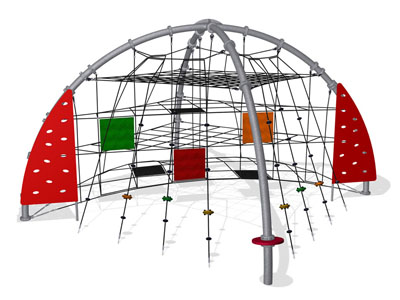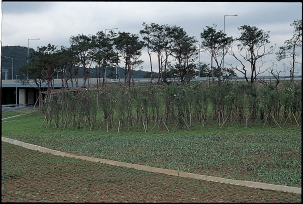
2010 상하이 엑스포의 중국 정원“畝中山水”

Mu Garden for the Chinese
Garden of Expo 2010 Shanghai
프로젝트 위치 및 배경
Mu Garden은 2010년 상하이 엑스포에서 전통과 현대가 융합된 중국의 정원을 보여주었다. 면적 27,000㎡의 Mu Garden은 황포강 수변공간의 남쪽, 엑스포 극장과 포명로 북쪽 광장 사이에 위치하고 있다. 이곳은 사람들이 모이거나 순환이 되어 머물기도 하는 곳이다. 엑스포가 끝난 후 대부분 전시관들을 허물었지만 Mu Garden은 중국관과 함께 남겨 문화유산물로서의 가치를 시민들에게 알리고자 하였다. 세계화가 만연해 있는 오늘날에 제한된 부지에서 중국 전통 문화와 현대적 특성을 융합한 현대 정원을 설계하는 것이 이번 프로젝트의 기본원칙이었다.
설계 목표
ECOLAND설계사무소는 이번 Mu Garden 프로젝트에서 기획 및 정원과 건축설계를 맡으면서 전통정원의 우수한 이념과 조원기법을 어떻게 계승 발전시킬 것인가를 염두에 두었다. 전통유산의 계승 발전은 그대로 따른 것이 아니라 전통 조원의 정취를 정확하게 이해하여
다듬는 것이기 때문이다. 또 서비스 수요에 대한 충분한 분석이 이루어진 후 수요층의 구조 및 자료선택, 그리고 문화적 소양에 맞춰야 할 것이다. 중국 전통정원이 세계정원에서 중요하게 언급되고 있는 이유는 중국정원이 한 걸음씩 뗄 때마다 보이경이步移景異, 시정화의詩情畵意, 소중견대小中見大등 새로운 풍경을 보여주면서 다양한 공간예술들을 체험할 수 있도록 했기 때문이다. 상하이 엑스포 내 정원을 현대중국식 경관으로 계획하는 데에는 수직성을 중요한 표현방식으로 사용하였다.
‘현대중국식 當代中式’과‘Mu Garden 畝中山水’의 구상
이번 프로젝트에서 대상지가 직면한 도전과 원칙을 배경으로하여 채택한‘현대중국식當代中式’계획은 현대의 기능을 결합하여 표현한 현대적 경관설계 방법으로, 중국 정원의 정신과 수양을 제시하고자 한 것이다. 이에 중국 고전 정원의 정취에서 함의, 수양 요소를 찾아 현대적 경관 심미의 형식과 수법을 이용하여 복잡한 것을 없애고 간략한 것을 취하도록 하였다. 중국 전통정원의 정신은 중국인이 자연산수와 땅에 깊고 진한 그리움을 지니고 있는 것에서 시작된다. 이런 그리움은 중국그림과“ 千里江山于方寸(규모가 작은 정원으로 넓은 강산을 보일 수 있다)”란 이름을 가진 정원에 잘 나타나 있다. 그리고 Mu Garden에서‘ 由人作, 宛自天成(사람이 만든 것이지만, 자연인 것 같다)’을 느낄 수 있다‘. 묘畝’는 수천 년부터 중국에서 사용하는 토지 면적의 기본단위이다. 설계자는‘묘畝’와‘원園’을 결합하여 전통 토지 단위인‘묘’를 단위로 오늘날의 중국 전통 명원의 9가지 감성을 재현하였다. 그리고 현대중국식의 실용적인 기능과 요소를 결합하여 畝中山水Mu Garden를 조성하였다.
As an example of this modern standard representing traditional and contemporary ideals, the Chinese Garden is presented. Chinese Garden is located on 6.7 acres on the east side of the Chinese pavilion at the 2010 World Expo in Shanghai. Prominently located next to the main performance venue, the Park will serve as a leisure ground to the estimated seventy million Expo visitors from around the world. As the host country of the World Expo, China will look to proudly display its illustrious culture and history while also showcasing its promising future. Recognizing this theme, Chinese Garden Park promotes a modern Chinese design style rooted in traditional techniques.
The design of the park is an interpretation of the mu, the Chinese measure unit for a lot of cultivated land. A mu is equivalent to one-sixth of an acre, with theparcels in a grid format. The park features nine gardens, or mu, as nine is an auspicious number in Chinese culture which represents infinity or long-lasting. These nine gardens make up one and a half acres of built garden space. The site posed a challenge, as it is located above two major subway lines and a canal, which dictate strict weight limitations over much of the site. The designers turned this challenge into an opportunity by breaking the nine garden parcels from the grid to redistribute weight capacities and create more space for the individual garden “Rooms.” In ancient times, garden space was limited and in order to make gardens seem larger, designers created walled-off rooms to provide a delightful variety of experiences. Like a landscape painting, these white walls provide a blank canvas to frame the greenery.
Location _ Shanghai, China
Area _ 27,000m²
Designer _ ECOLAND(David Chen)
Design _ 2008~2010
Construction _ 2009~2010
Completion _ 2010.4
Translation _ Liu, Yi Hong
- 김세영 · 편집부
-
다른기사 보기
klam@chol.com





















